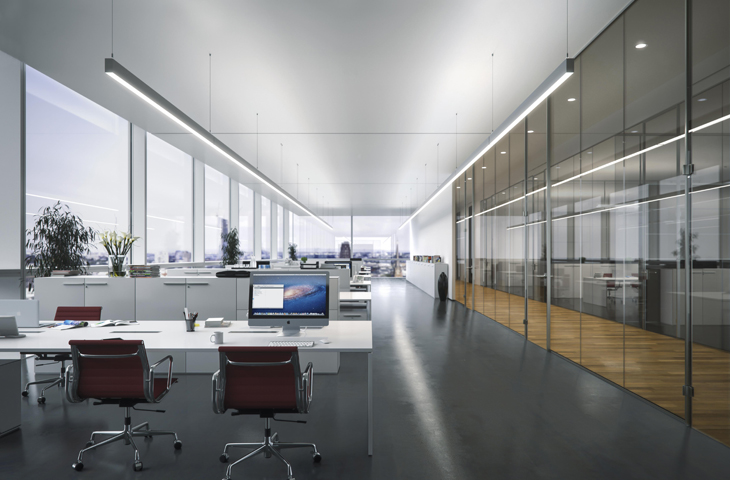
Computers have become an integral part of office life. The average office worker spends 1,700 hours per year in front of a screen, that’s 6.5 hours of every working day. While much can be achieved by way of our PCs, all this screen time comes at a cost. Then to add to this, we spend a significant time looking at our mobile phones and tablets.
There are many issues that can result from overexposure to computers and mobile phones and these can vary from person to person. Eye strain, eye dryness, headaches, tiredness or even a temporary change in one’s ability to see colours can all be directly related to your screen. It’s clear that these forms of technology won’t be going anytime soon, and while regular breaks can help prevent many of the above issues, one simple solution that yields benefit beyond just computers is lighting.
Proper lighting of an office environment has proven to help ergonomics and reduce the harmful impacts of long term screen exposure. Not only this, good lighting can boost employee moods, lower absenteeism and improve concentration. Workplace health and safety is another added bonus, adequate lighting can help workers identify hazards more readily, preventing accidents and ensuring the safety of your environment. Flickering lights, for example, are not just a distraction to workers, if they are the only source of illumination they can contribute to tripping hazards, potentially causing injury. All in all, lighting has much more impact than you might think!
There is a drive these days to move to LED type lighting, and the technology in LED has come a long way since its first introduction. This form of lighting is low energy and offers a consistent daylighting but is should be noted however that certain LED lighting has been proven to cause strain on eyes and has had detrimental effects on ones health due to the frequency by which they operate. It is important to review the performance of the LED options before these are selected.
So what is the best way to light your office, boost productivity and ensure the safety of your workforce? It all depends on the environment and the type of work you are doing. A couple of things to consider are:
To maximise the comfort and productivity of your workforce, it is generally best to have an even amount of light throughout a space. Most people prefer to work in natural daylight, so it is important to strategically use windows to balance-out the electric lights (doing so will also save your power bill). Avoid facing computer screens towards windows, this will create screen glare and will hasten the worker’s eye fatigue. If it is a particularly bright day, you can use blinds to moderate the amount of light to a level that is comfortable.
The type of work you are doing will affect the amount of light in certain areas. Generally, the more detailed your task the brighter the room requirements are. Illumination is measured in lux, the light of the family living room is usually around 50 lux, while a hospital operating theatre sits at around 1000 lux.
Industry guidelines for offices, industrial kitchens and laboratories recommend around 200 to 600 lux to work effectively. This is the sweet spot of day to day work that has a certain level of detail. Areas where work is not done i.e. lunch rooms and hallways will require less illumination (around 100 lux) to ensure safety and break-up the bright areas to avoid eye fatigue.
Finally, the interior design of a room will also factor into your lighting strategy. Small offices will require different lighting to open-plan offices, particularly if there is less natural light. In small offices, the lighting fixture should always be above the workspace, this prevents shadows and glare on your screen. The wall colours also need to be considered. Walls painted in dark colours will
absorb light and reflect very little, the opposite is true of light colours.
Proper workplace illumination is one thing many of us don’t think about when it comes to being productive at work. Hopefully we’ve helped shed some light on the situation and made your workplace more efficient and comfortable.
If you need a lighting strategy audit for your workplace call Karsons Consulting today 020 3282 7605 or info@karsonsconsulting.com.
Karsons Consulting are members of the Chartered Institute of Building Services Engineers, The Association of Consultancy and Engineering, British Institute of Facilities Managers and the Building Services Research and Information Association.